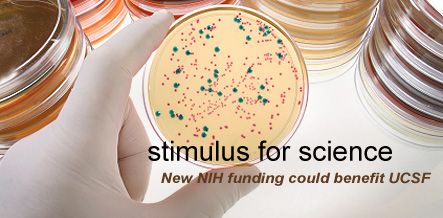As one of the country’s largest recipients of National Institutes of Health (NIH) funding, UCSF has reason to celebrate the news of a $10 billion boost to the NIH under the new economic stimulus package.
With more than $8 billion set to go directly toward funding studies, University researchers are hopeful that projects that have been underfunded for the past few years will see some of that money.
“It has been very hard for both junior and senior investigators to do the research they want, as there’s been a steady, real-dollar decrease in the NIH budget,” said neurologist Bruce Miller, MD, director of the UCSF Memory and Aging Center.
UCSF has consistently ranked among the top recipients of NIH grants and awards. Major funding in 2008 included:
- A seven-year, $24.4 million grant for the UCSF School of Dentistry to prevent early childhood tooth decay and address oral health disparities.
- An award of $400,000 over three years from the NIH’s Fogarty International Center to promote global health education and research.
- A $6 million biomedical technology grant for a team led by Michael Weiner, MD, UCSF professor of radiology, to improve equipment used to diagnose and track neurodegenerative diseases like Alzheimer’s, Parkinson’s and traumatic brain injuries.
“It’s a serious concern because the boldness with which scientists pursue their research is directly related to how they perceive the sustainability of their [financial] support,” added Keith Yamamoto, PhD, executive vice dean of the UCSF School of Medicine and a member of the Working Group of the Advisory Committee to the NIH Director.
After doubling between 1998 and 2003, NIH funding stayed stagnant for six years under the Bush administration a trend that was keenly felt on UCSF’s campuses, despite the fact that in 2007, the University was the third-largest recipient of NIH research support, to the tune of nearly $439 million.
“We haven’t had good news from the NIH in about eight years,” Miller said, calling the recent development “simply fantastic.”
Miller singled out three areas of research at the Memory and Aging Center that have stalled during the lean years: Studies of cognitive function in healthy adults; clinical trials of treatments for non-Alzheimer’s dementia; and a proposed project by neurologist Howard Rosen, MD, that would use brain imaging to study frontotemporal dementia, the most common cause of early-onset dementia.
Along with the funding news, there is much talk of an imminent overhaul of Bush administration policies surrounding human embryonic stem cell research something President Barack Obama has pledged to do.
Arnold Kriegstein, MD, PhD, director of UCSF’s Eli and Edythe Broad Center of Regeneration Medicine and Stem Cell Research, said he hopes his own area of research will see a “surge” in funding as a result of this expected policy change.
“We’re all absolutely thrilled by the shift in attitude toward science research and the importance of funding research projects like these,” he said.
But Kriegstein said he was concerned by the requirement in the new stimulus package which Obama signed into law on Feb. 17 – that the NIH spend the entire $10 billion over the next two years.
“Medical research is a slow and long process, and really requires continuous support over a long period of time in order to achieve significant goals,” he said. “The [$10 billion] has to be carefully managed because it needs to lead to a sustained development of new research projects, and not just a blip of increased funding.”
In a conference call on Feb. 20, acting NIH director Raynard Kington, MD, PhD, acknowledged that it may not “make sense scientifically” to fund certain longer-term projects and clinical trials for only two years. As a result, those applicants won’t receive stimulus funds, he said.
“If you don’t think you can spend the money in two years, you should not apply,” he said.
Though the details of how the NIH will portion out the $10 billion are “still in the early stages of being developed,” Kington identified three general ways in which the $8 billion in research funding will be distributed: through the traditional NIH Research Project Grant (R01) program; through supplements to existing grants and contracts; and through so-called challenge grants, two-year grants of about $1 million each that focus on “specific science and health challenges” identified as top priorities by NIH institutes and centers.
Kington said the current plan is to devote $100 million to $200 million to the challenge grant program, although a final dollar figure has not been determined.
Under the stimulus package, the NIH is required to provide regular reports to Congress and the White House on the status of all the clinical trials and projects it decides to fund over the next two years, and those reports will require a level of detail “unlike anything you’ve ever seen before,” Kington said.
“We need to show the direct economic impact of our investments in a concrete way,” he said.
It remains to be seen how UCSF will fare as the funds are doled out in the coming weeks and months. But however big the slice, the pie will taste sweet, Miller said.
“The people here [at UCSF] are so talented and can do so much with the proper funding,” he said. “This will change the whole climate of the scientific community.”
It is also a call to action, Yamamoto said, noting that as the NIH prepares to announce how it will spend its stimulus money, Obama is preparing to introduce his own federal budget for 2010 in early March.
“This is an incredibly critical time to make our voices heard as loudly as possible about the importance of funding basic scientific research both to the progress of science and to the economy,” he said.
Related Links:
UCSF Memory and Aging Center
Eli and Edythe Broad Center of Regeneration Medicine and Stem Cell Research at UCSF
Yamamoto Lab at UCSF
UCSF Among Top Universities in NIH Funding
UCSF News Release, April 18, 2008
